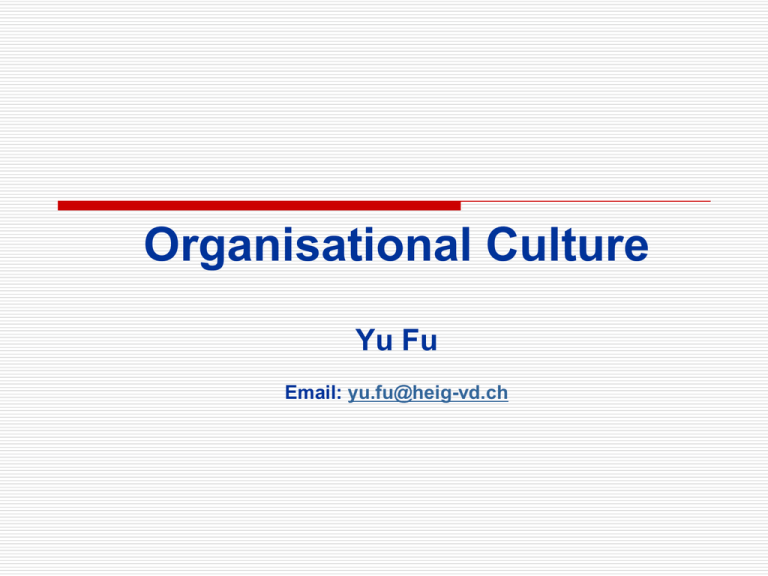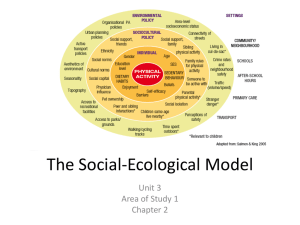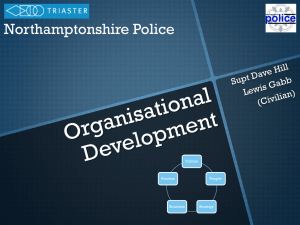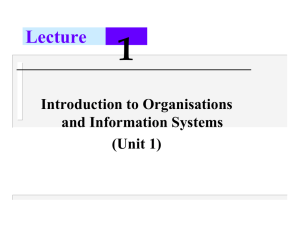Organisational culture - Moodle HES-SO
advertisement

Organisational Culture Yu Fu Email: yu.fu@heig-vd.ch Learning objectives • What is organisational culture? • How do you understand an organisational culture? • How can the organisational culture be managed? Organisational Behaviour 2 2 Organisational Culture • A system of beliefs, customs, values, and attitudes shared and transmitted by members of a particular group or organisation. • The system of shared meaning is, on closer examination, a set of key characteristics that the organisation values. Organisational Behaviour 2 3 Organisational Behaviour 2 4 Primary Characteristics • • • • • • • Innovation and risk taking Attention to details Outcome orientation People orientation Team orientation Aggressiveness Stability Organisational Behaviour 2 5 Organisational Culture • Innovation and risk taking (3M) • Outcome orientation (Bausch & Lomb) • Aggressiveness: to enable people and businesses throughout the world to realise their full potentials (Microsoft) http://www.youtube.com/watch?v=MSSeDJPVfrY Organisational Behaviour 2 6 Organisational Behaviour 2 7 Comparison of Two Competing Perspectives on Organisational Culture VARIABLE • Something the organisation “has”; a tool, skill, or lever • Inform workplace of values • Change occurs through management directive and intervention ROOT METAPHOR • Something the organisation “is”; expressive form • Create sustain and influence culture • Change occurs through natural evolution; all members influence culture Organisational Behaviour 2 8 Organisational Culture • Culture is SHARED • Culture is INTANGIBLE • Culture AFFECTS HUMAN BEHAVIOUR • Communicative creations • Historical Organisational Behaviour 2 9 Organisational Culture Artifacts • • • • Stories/legends Rituals/ceremonies Organisational language Physical structures/décor Visible Shared values • Conscious beliefs • Evaluate what is good or bad, right or wrong Invisible (below the surface) Shared assumptions • Unconscious, taken-for-granted perceptions or beliefs • Mental models of ideals Organisational Behaviour 2 10 Elements of Culture • Artifacts: things representing group beliefs & culture. • Values: beliefs about use of time and hard work; the way things ought to be (according to founder). • Basic assumptions: core beliefs of the group, relationship between individuals and group, supervisor-supervisee relationships, risk-taking, new worker orientation, benefits. Organisational Behaviour 2 11 Functions of Organisational Culture • • • • Culture provides a sense of identity to members and increases their commitment to the organisation Culture is a sense-making device for organisation members Culture reinforces the values of the organisation Culture serves as a control mechanism for shaping behaviour Organisational Behaviour 2 12 Do Organisations Have Uniform Cultures? • Organisational culture represents a common perception held by the organisation’s members. • Most large organisations have a dominant culture and numerous sets of subcultures. Organisational Behaviour 2 13 Organisational Culture • A dominant culture expresses the core values that are shared by a majority of the organisation’s members. • Subcultures tend to develop in large organisations to reflect common problems, situations, or experiences that members face. Organisational Behaviour 2 14 Problems associated with subcultural divisions within the larger culture • Subordinate groups are likely to form into a counterculture pursuing self-interests. • The firm may encounter extreme difficulty in coping with broader cultural changes. • Embracing natural divisions from the larger culture may lead to difficulty in international operations. Organisational Behaviour 2 15 What Organisational Culture Does FUNCTIONS • Provides an external identity • Creates a sense of commitment • Acts as source of high reliability • Defines an interpretive scheme • Acts as a social control mechanism DYSFUNCTIONS • Can create barriers to change • Can create conflict within the organisation • Subcultures can change at different rates than other units Organisational Behaviour 2 16 Wal-Mart, Inc. • Wal-Mart’s headquarters almost screams out frugality and efficiency. The world’s largest retailer has a spartan waiting room for suppliers, rather like a government office waiting areas. Visitors pay for their own soft drinks and coffee. In each of the building’s inexpensive cubicles, employees sit at inexpensive desk finding ways to squeeze more efficiencies and lower costs out of suppliers as well as their own work processes. Organisational Behaviour 2 17 ICICI Bank • • India’s second largest bank exudes a performanceoriented culture. Its organisational practices place a premium on training, career development, goal setting, and pay-for-performance, all with the intent of maximizing employee performance and customer service. “We believe in defining clear performance for employees and empowering them to achieve their goals “ says ICICI Bank executive director Kalpana Moraria. “This has helped to create a culture of high performance across the organisation. Organisational Behaviour 2 18 Convergence or Divergence? • • • • Industrialisation Emphasis on standardisation Organisational strategies for managing culture globally Emphasis on consistency across borders – MNCs – Global institutions • • • Use of organisational culture as a competitive tool Impact of diverse national cultures on organisational culture Benefits in specific and culturally sensitive ways – Seniority – Job security – Group versus individual Organisational Behaviour 2 19 National culture influences • Widely held common assumptions may be traced to the larger culture of the host society. • National cultural values may become embedded in expectations of organisation members. Organisational Behaviour 2 20 National culture influences • National culture must be taken into account if accurate predictions are to be made about organisational behaviour in different countries. • The research indicates that national culture has a greater impact on employees than does their organisation’s culture. Organisational Behaviour 2 21 Culture-Free Approach It argues that technology, policies, rules, organisational structure, and other variables that contribute to efficiency and effectiveness make national culture irrelevant for management. • McDonald’s fast food service • World Disney • IKEA Organisational Behaviour 2 22 Implications for Managers • • • • For managerial effectiveness, it is helpful to analyse organisational cultures in order to coordinate activities or change them; Understand what levels of culture can be influenced and how; Know how national culture and organisational culture can interact to influence management philosophy and employee behaviours. Person-culture fit for individual career success Organisational Behaviour 2 23 EXERCISES: What Does Our Culture Reveal About Us? 1. pick an organisation to examine—social group, the college or university, a workplace, and so on. 2. Evaluate that organisation’s culture in terms of the list of signs that reveal its culture. 3. Draw a conclusion as to the nature of its culture. Organisational Behaviour 2 24







